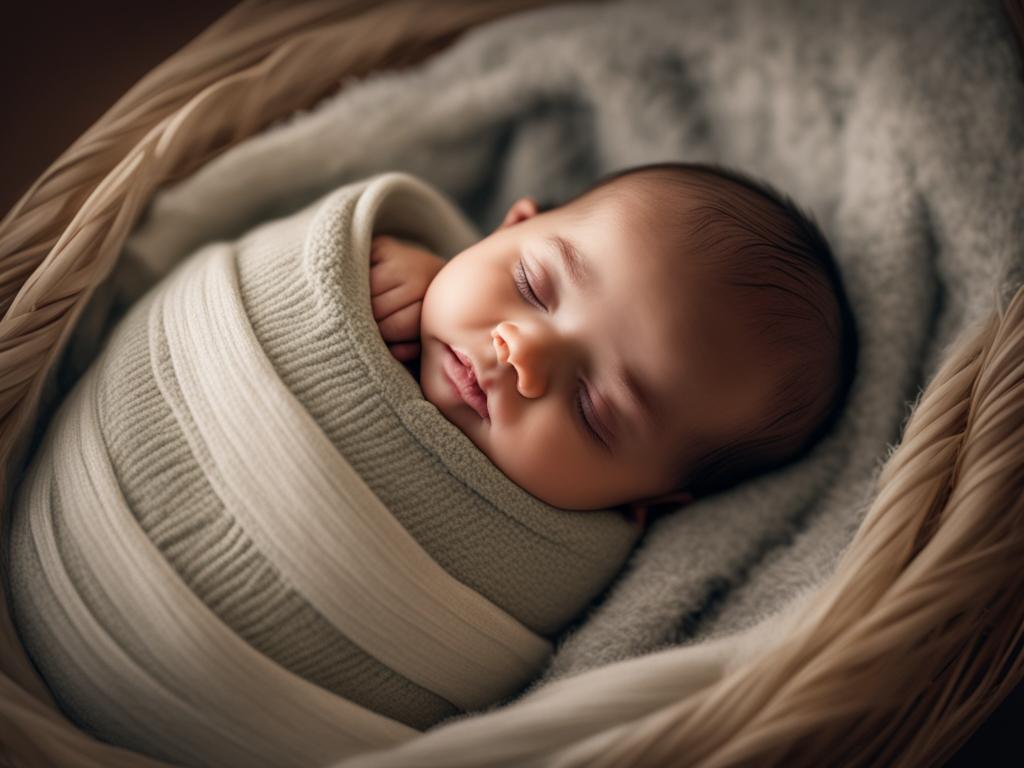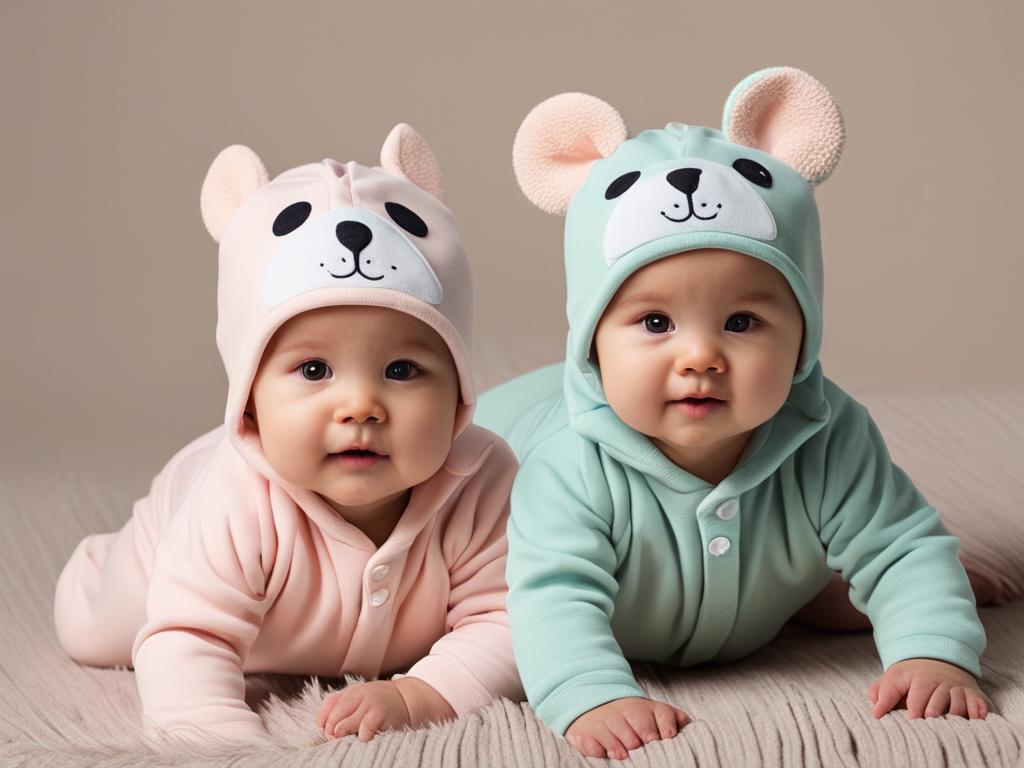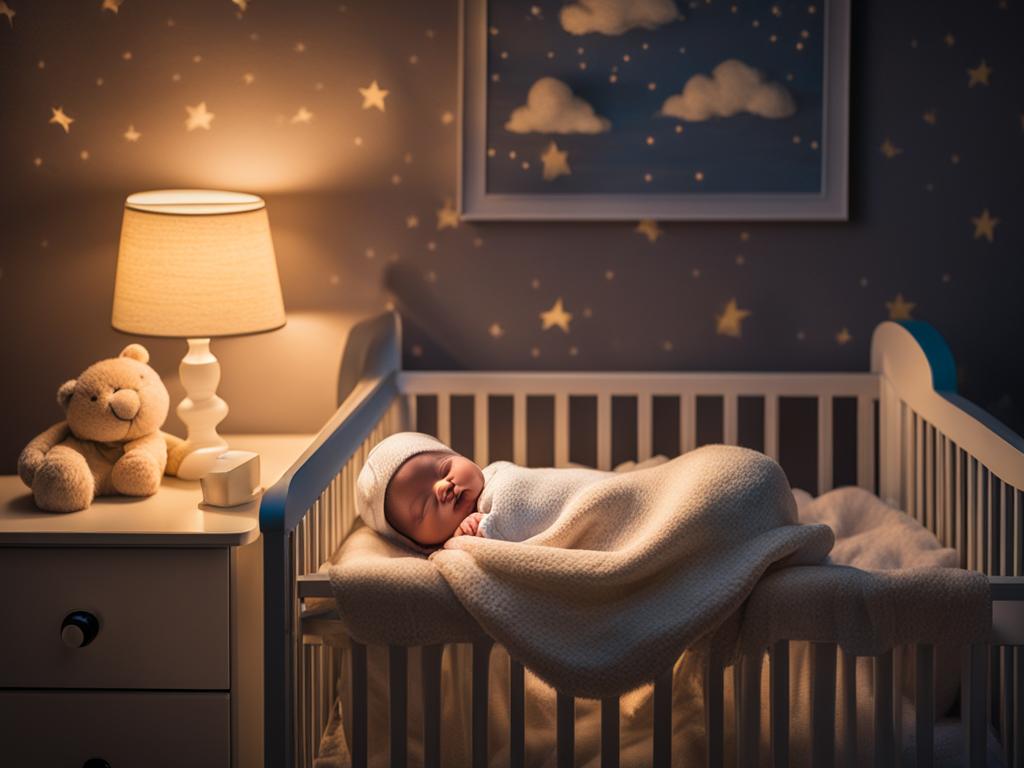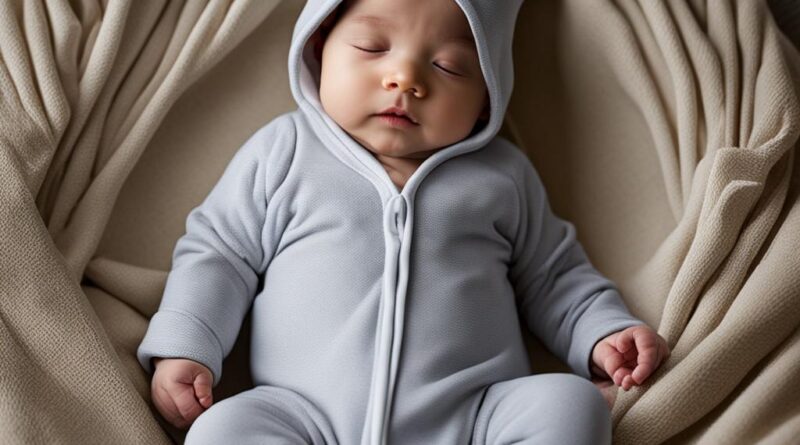Guide: How to Dress Baby For Sleep Safely & Comfortably
Dressing a baby for sleep is crucial for their safety and comfort. As parents, it can be challenging to determine the best way to dress your baby for sleep while ensuring they don’t get too hot or too cold. The right sleepwear can make all the difference in creating a cozy and secure sleeping environment for your little one.
When it comes to dressing your baby for nighttime sleep, there are a few key considerations to keep in mind. The room temperature, the type of sleepwear, and the age of your baby are all factors that should be taken into account. By following some simple guidelines, you can ensure that your baby is dressed appropriately for a comfortable and safe sleep.
Not sure where to start? This guide will provide you with valuable information on how to dress your baby for sleep, the importance of choosing the right sleepwear, and tips for maintaining a comfortable sleep environment. Let’s dive in!
- Choosing the right sleepwear is crucial for your baby’s safety and comfort during sleep.
- Dress your baby in layers appropriate for the room temperature, and avoid over-bundling or covering their head with blankets.
- Consider using wearable blankets or sleep sacks instead of traditional blankets.
- Swaddling can be beneficial for newborns but should be stopped once they start rolling over on their own.
- Consult with a pediatrician for specific advice tailored to your baby’s needs.
How Should You Dress a Baby for Sleep?
When it comes to dressing a baby for sleep, finding the right balance between comfort and safety is key. Here are some tips to help you choose the appropriate sleepwear for your little one:
Dress in layers
Experts recommend dressing your baby in layers that are suitable for the room temperature. This allows you to easily adjust their clothing as needed. A good rule of thumb is to dress your baby in one more layer than what you would wear to stay comfortable in the same environment.
Avoid over-bundling
While it’s important to keep your baby warm, over-bundling can lead to overheating and discomfort. To prevent this, dress your baby in lightweight and breathable fabrics, such as cotton. Onesies are often a good option as a primary layer of sleepwear.
Avoid blankets and hats
It’s important to avoid using blankets or hats in the crib, as they can pose suffocation risks. Instead, consider using sleep clothing that provides the necessary warmth without the need for additional coverings. Sleep sacks or wearable blankets can be a safe alternative to traditional blankets.
By dressing your baby in layers appropriate for the room temperature and avoiding over-bundling or the use of blankets and hats, you can help ensure that your little one sleeps safely and comfortably.
Should You Swaddle Your Baby?
Swaddling is a common practice that involves wrapping a baby in a thin blanket to provide comfort and mimic the sensation of being in the womb. It can help calm some babies and promote better sleep. However, it is essential to consider the potential risks and benefits of swaddling.
Swaddling is generally considered safe for newborns, as it can help them feel secure and prevent the startle reflex from waking them up. However, it is crucial to stop swaddling once the baby starts showing signs of rolling over on their own. Swaddling restricts their movement, and they may not be able to free their arms or change their position if necessary.
When swaddling your baby, it is important to ensure that the swaddle is not too tight. A tight swaddle can restrict the baby’s movement and hinder their ability to breathe properly. It is recommended to use a lightweight and thin blanket for swaddling, ensuring that it leaves enough room for the baby to move their hips and legs comfortably.
Consulting with a pediatrician is always advised when considering swaddling or any other sleep practices for your baby. They can provide personalized advice based on your baby’s specific needs and development.

Benefits of Swaddling
Swaddling can offer several benefits for newborns, including:
- Promoting better sleep by providing a sense of security and comfort.
- Reducing the startle reflex, which can disrupt sleep.
- Mimicking the feeling of being in the womb, which can help soothe and calm babies.
Safe Swaddling Practices
To ensure safe swaddling, follow these guidelines:
- Use a lightweight and breathable blanket to prevent overheating.
- Swaddle the baby snugly but not too tight, allowing for proper movement of the hips and legs.
- Stop swaddling once the baby shows signs of rolling over on their own.
- Always place the baby to sleep on their back when swaddled.
- Monitor the baby during sleep to ensure they are breathing comfortably.
How Do You Know if Your Baby Is Comfortable?
Ensuring that your baby is comfortable while sleeping is essential for their well-being. While babies can’t communicate their comfort levels verbally, there are several signs you can look for to assess their comfort.
To determine if your baby is comfortable, it’s important to assess their core temperature. Instead of relying on their hands or feet, check their chest, neck, back, and tummy. If your baby feels warm and sweaty, or their chest feels hot to the touch, it may indicate that they are too hot. On the other hand, if their core feels cool, it may suggest that they are too cold.
It’s crucial to dress your baby appropriately for the room temperature. Dress them in layers that can be easily adjusted depending on the temperature. Avoid overdressing or over-bundling, as this can lead to overheating. Additionally, make sure to avoid covering your baby’s head with blankets, as it can restrict airflow and pose a suffocation risk.
By monitoring your baby’s core temperature and dressing them in suitable sleepwear, you can help ensure their comfort and promote a restful sleep.
| Signs of Baby Discomfort |
|---|
| Signs of being too hot: • Sweating • Flushed cheeks • Chest feels hot to the touch |
| Signs of being too cold: • Cool core temperature |
Tips for Baby Sleepwear
Choosing the right baby sleepwear is essential for ensuring a safe and comfortable sleep environment for your little one. Here are some tips to help you select the perfect sleepwear:
- Opt for lightweight and breathable fabrics like cotton to keep your baby comfortable throughout the night.
- Ensure that the sleepwear fits your baby well, allowing freedom of movement without being too tight or restrictive.
- Consider sleepwear with convenient features, such as snaps or zippers, that make diaper changes during the night easier for both you and your baby.
- It’s important to have multiple pieces of sleepwear, so you always have a clean and dry option for your baby.
Remember to avoid any clothing items that could pose safety hazards, such as items with ties or small buttons that could be a choking risk. Additionally, do not attach pacifiers or any other objects to your baby’s clothes while they sleep. By following these tips, you can help create a comfortable and safe sleep environment for your little one.

Tips for Choosing Baby Sleepwear Table:
| Sleepwear Feature | Benefits |
|---|---|
| Lightweight and breathable fabrics | Keeps baby comfortable and prevents overheating |
| Proper fit | Allows freedom of movement without being too tight or restrictive |
| Convenient closures | Makes diaper changes easier during the night |
| Multiple pieces | Ensures clean and dry sleepwear options |
| No safety hazards | Avoids choking risks from ties, small buttons, or attached objects |
Recommendations for Safe Sleeping
When it comes to ensuring a safe sleep environment for your baby, following expert recommendations is crucial. The American Academy of Pediatrics provides specific guidelines that can help reduce the risk of sudden infant death syndrome (SIDS) and create a secure sleeping space.
First and foremost, it is advised to place the baby to sleep on their back. This position has been shown to lower the risk of SIDS significantly. Additionally, room sharing without bed sharing is recommended. Having the baby sleep in the same room as the caregiver, but not in the same bed, promotes safe sleeping habits.
Using a firm and flat sleep surface is also important. Avoid placing pillows, soft blankets, or other objects in the crib that could potentially suffocate the baby. The crib itself should meet safety standards and have no loose or broken parts that could pose a hazard.
As for the baby’s sleepwear, it should be appropriate for the room temperature. Dressing the baby in layers can help regulate their body temperature without the use of blankets. Remember to avoid covering their heads and ensure that sleepwear is made of lightweight and breathable fabrics.
| Safe Sleeping Recommendations |
|---|
| Place the baby to sleep on their back |
| Room share without bed sharing |
| Use a firm and flat sleep surface |
| Avoid blankets and soft objects in the crib |
| Dress the baby in appropriate sleepwear for the room temperature |
Following these recommendations can provide parents with peace of mind, knowing that they are taking steps to create a safe sleep environment for their baby. It is essential to prioritize the safety and well-being of the baby during sleep to ensure a restful and secure experience.
What is the Best Temperature for Baby Sleep?
Ensuring the right temperature in your baby’s sleep environment is important for their comfort and safety. The ideal room temperature for baby sleep is often recommended to be between 68℉ and 72℉ (20℃ – 22℃). However, it is essential to note that different homes may have varying temperatures, and what matters most is dressing your baby appropriately for the temperature of the room.
Experts advise dressing your baby in one more layer than what you would wear to stay comfortable in that environment. This helps ensure that your baby stays warm enough without overheating. Monitoring your baby’s core temperature can also be helpful in determining if they are too hot or too cold.
It is important to consider signs of overheating, such as sweating, flushed cheeks, and feeling hot to the touch, as indications that your baby may be too warm. On the other hand, if your baby feels cool to the touch and has a cool core temperature, they may be too cold and require an extra layer of clothing. Striking a balance and dressing your baby appropriately for the room temperature will help ensure their comfort while they sleep.
Table: Guidelines for Dressing Baby Based on Room Temperature
| Room Temperature | Recommended Dressing |
|---|---|
| Below 64℉ (18℃) | Dress your baby in warm layers, such as a onesie, footed pajamas, and a sleep sack or wearable blanket. |
| 64℉ – 72℉ (18℃ – 22℃) | A onesie or a light sleeper with a sleep sack or wearable blanket should be sufficient. |
| Above 72℉ (22℃) | Dress your baby in a lightweight onesie or sleeper without additional layers. |
Remember, these guidelines are approximate, and every baby is different. It’s essential to monitor your baby’s comfort and adjust their clothing as needed. By dressing your baby appropriately for the room temperature, you can help them sleep comfortably and safely.
Should Newborns Wear Hats to Sleep?
When it comes to dressing newborns for sleep, a common question that parents have is whether or not their little ones should wear hats to bed. According to the American Academy of Pediatrics, newborns do not need to wear hats while sleeping or even indoors after the first few hours of life. While hats may have been used in the hospital to help regulate a baby’s temperature initially, they are not necessary for temperature regulation indoors. It is important to avoid any loose items or clothing in the crib, including hats, to reduce the risk of suffocation.

During sleep, a baby’s body maintains its temperature naturally, and their heads do not release or retain heat significantly more than the rest of their body. As long as the room is kept at a comfortable temperature, generally between 68℉ and 72℉ (20℃ – 22℃), there is no need for babies to wear hats. However, it is essential to dress newborns appropriately for the room temperature by using layered clothing made of lightweight and breathable fabrics, such as cotton.
In summary, newborns should not wear hats to sleep or even indoors for temperature regulation. Ensuring a comfortable room temperature and dressing babies in appropriate sleepwear are key factors in promoting safe and comfortable sleep for newborns.
Are Baby Monitor Temperatures Accurate?
Baby monitors are a popular tool for parents to keep an eye on their little ones while they sleep. Many modern baby monitors come equipped with temperature sensors, which claim to provide accurate readings of the room’s temperature. However, it is important to note that the accuracy of these temperature measurements can vary.
While some baby monitors may provide relatively accurate temperature readings, it is important not to rely solely on these readings to determine whether your baby is comfortable. Factors such as monitor placement, distance from the baby, and interference from other devices can all impact the accuracy of the temperature measurements.
To ensure your baby’s comfort, it is recommended to manually assess the temperature of the room by entering it and observing your baby for signs of being too hot or too cold. Additionally, dressing your baby in appropriate sleepwear for the room temperature can help maintain their comfort throughout the night.
| Pros | Cons |
|---|---|
| Convenient way to monitor room temperature | Accuracy may vary |
| Can provide a general indication of temperature | Reliance on temperature readings alone may lead to overlooking other comfort cues |
| Factors such as monitor placement and interference can affect accuracy |
In conclusion, while baby monitor temperature readings can provide a general indication of the room’s temperature, they may not always be entirely accurate. It is important for parents to manually assess the temperature and rely on other comfort cues from their baby to ensure they are dressed appropriately for a comfortable and safe sleep environment.
How Many Layers Should a Newborn Wear?
Dressing a newborn for sleep requires careful consideration to ensure their comfort and safety. Determining the number of layers needed can be challenging, but following expert recommendations can help create an optimal sleep environment. The American Academy of Pediatrics advises dressing an infant in one additional layer than what adults would wear in the same environment. However, it is important to assess the baby’s core temperature to determine if additional layers are necessary.
Monitoring the baby for signs of being too hot or too cold is essential. A baby who feels hot to the touch, has flushed cheeks, or is sweating may be overdressed and overheating. On the other hand, a baby with cool extremities or a cool core temperature may need an extra layer. Finding the right balance is crucial to ensure the baby’s comfort and avoid safety risks associated with overheating or cold.
Consulting with a pediatrician can provide personalized guidance on dressing a newborn for sleep. Every baby is unique, and specific considerations such as the room temperature and the baby’s individual needs should be taken into account. By using a layering approach and regularly assessing the baby’s comfort, parents can ensure that their newborn is dressed appropriately for a restful and safe sleep.
| Signs of Overheating | Signs of Being Too Cold |
|---|---|
|
|
Conclusion
Dressing your baby for sleep is a vital aspect of ensuring their safety, comfort, and overall quality of sleep. By following a few key guidelines, you can create a sleep environment that promotes healthy rest for your little one.
First and foremost, it’s important to dress your baby in layers appropriate for the room temperature. This will help you avoid over-bundling or overheating your baby, which can be unsafe. Choosing lightweight and breathable fabrics for their sleepwear, such as cotton, can provide optimal comfort.
Furthermore, it’s crucial to follow safe sleep recommendations, such as placing your baby on their back and removing blankets and soft objects from the crib. Swaddling can be beneficial for newborns but should be discontinued once they start rolling over on their own.
When choosing baby sleepwear, ensure that it is free from any potential safety hazards. Avoid tying any items or pacifiers to their clothes and remove buttons or small objects that could pose a choking risk.
Remember, consulting with a pediatrician can provide you with specific advice tailored to your baby’s needs. By taking these measures, you can help ensure that your baby sleeps safely and comfortably throughout the night.
FAQ
How should you dress a baby for sleep?
Dressing a baby for sleep involves dressing them in layers appropriate for the room temperature. It is recommended to dress the baby with one more layer than what an adult would need to stay warm in the same environment. Onesies can often serve as an effective primary layer of sleepwear. Avoid over-bundling the baby, as it can lead to safety risks from overheating. The use of blankets should be avoided to prevent suffocation, and sleep clothing can be layered to provide necessary warmth. Specific recommendations for dressing a baby for sleep may vary, so consulting with a pediatrician is advised.
Should you swaddle your baby?
Swaddling involves wrapping a baby in a thin blanket to provide comfort and mimic the feeling of being in the womb. Swaddling can calm some babies and help them sleep, but it is important to consider the potential risks and benefits. Swaddling is generally considered safe for newborns but should be stopped when the baby starts showing signs of rolling over on their own. It is crucial to ensure that the swaddle is not too tight, as it can restrict the baby’s movement and impact their ability to breathe. It is recommended to use a light and thin blanket for swaddling and to follow safe sleep guidelines.
How do you know if your baby is comfortable?
Instead of relying on the baby’s hands or feet, it is recommended to assess the baby’s core (chest, neck, back, and tummy) to determine their body temperature. Signs of a baby being too hot include sweating, flushed cheeks, and a chest that feels hot to the touch. On the other hand, a baby feeling too cold may have a cool core temperature. Babies should be dressed appropriately for the room temperature to ensure their comfort.
What are some tips for baby sleepwear?
Choosing the right baby sleepwear can contribute to a safe and comfortable sleep environment. It is recommended to have four to six pieces of sleepwear, ensuring there is always something clean and dry for the baby. Gown-like sleep clothing that is easy to open at the bottom can be convenient for nighttime diaper changes. Lightweight and breathable fabrics, such as cotton, are preferable for baby sleepwear. It is important to avoid safety hazards by not tying any items, including pacifiers, to the baby’s clothes. Buttons and small objects on clothing should also be removed to prevent choking hazards.
What are the recommendations for safe sleeping?
Expert organizations like the American Academy of Pediatrics provide specific recommendations to ensure safe sleeping for babies. These recommendations can help reduce the risk of sudden infant death syndrome (SIDS). They include placing the baby to sleep on their back, room sharing without bed sharing, using firm and flat sleep surfaces, removing blankets and soft objects from the crib, and checking the crib construction for safety. Following these recommendations can create a safe sleep environment for babies.
What is the best temperature for baby sleep?
The ideal room temperature for baby sleep is often recommended to be between 68℉ and 72℉ (20℃ – 22℃). However, it is important to consider that different homes may have varying temperatures, and babies can still be comfortable and safe as long as they are dressed appropriately for the temperature. The goal is to dress the baby in one more layer than what the caregiver would wear for that environment. Monitoring the baby’s core temperature and assessing for signs of overheating or being too cold can help ensure their comfort.
Should newborns wear hats to sleep?
According to the American Academy of Pediatrics, newborns should not wear hats to sleep or even indoors after the first few hours of life. Hats may have been used in the hospital to help regulate the baby’s temperature initially, but they are not necessary for temperature regulation indoors. It is important to avoid any loose items or clothing, including hats, in the crib to reduce the risk of suffocation.
Are baby monitor temperatures accurate?
Baby monitors may not always provide accurate or reliable temperature readings. It is recommended to manually assess the temperature of the room by entering it and observing the baby for signs of being too hot or too cold. The temperature reading on a monitor can serve as a general indication, but it should not be the sole factor in determining the baby’s comfort.
How many layers should a newborn wear?
Newborns may initially require an additional layer to help regulate their body temperature. However, after the first few days, they can be dressed in a similar manner to the caregiver. The official recommendation from the American Academy of Pediatrics is that an infant should not be dressed in more than one additional layer than adults in the same environment. Assessing the baby’s core temperature can help determine if additional layers are needed.

